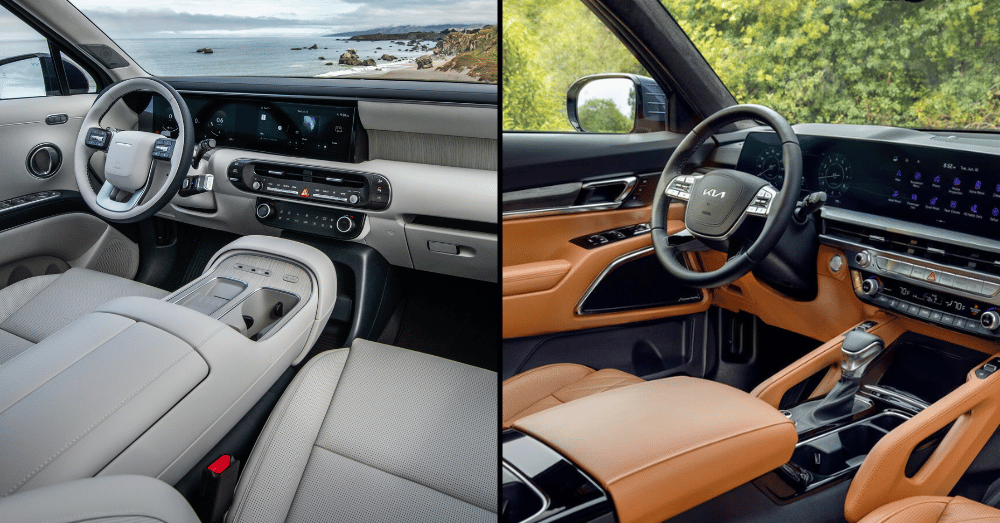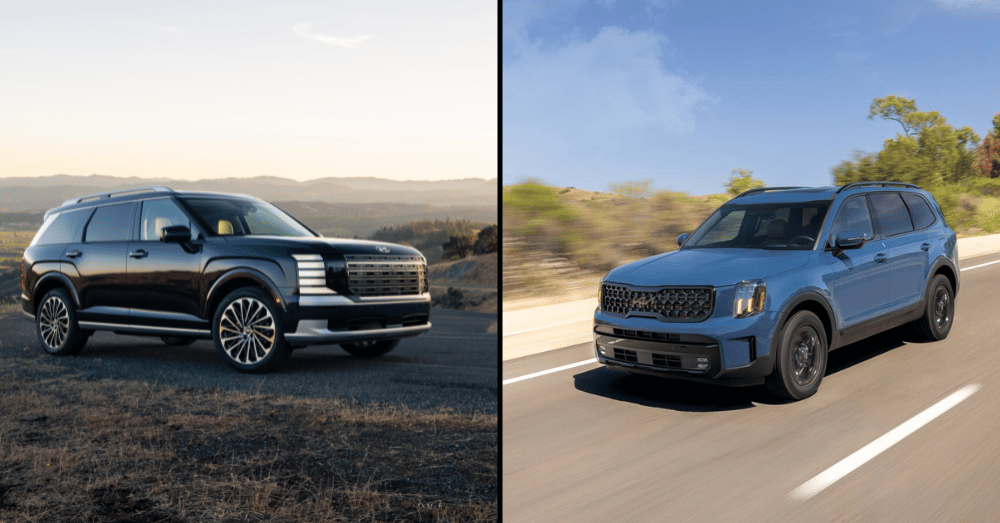Hyundai just rolled out the redesigned 2026 Palisade with fresh styling, new engines, and upgraded tech. The question everyone’s asking is whether these changes are enough to pull ahead of the Kia Telluride, which has owned the three-row SUV segment since both vehicles launched in 2020. These Korean cousins share the same platform and have been trading wins in comparison tests for years. Now one has a head start with a full redesign while the other waits in the wings.
- The 2026 Palisade starts at $41,035 compared to the Telluride’s $37,885, but offers wireless CarPlay and parking sensors as standard
- Palisade’s new 287-hp V6 is actually slower than before, taking 8.8 seconds to hit 60 mph versus the Telluride’s 7.5 seconds
- A new Palisade Hybrid with 258 horsepower joins the lineup and should deliver fuel economy in the low to mid-30s
Price Tags Tell Part of the Story
The Telluride holds a clear advantage when you compare base prices. You’ll spend about $3,150 less getting into a Telluride than its Korean cousin. Both come standard with eight seats, LED headlights, a 12.3-inch touchscreen, and all the driver assistance tech you’d expect. The Telluride even throws in synthetic leather seats as standard equipment, while the Palisade base trim sticks with cloth.
That price gap shrinks when you look at what Hyundai includes. The Palisade comes with wireless smartphone connectivity, front and rear parking sensors, and automatic reverse braking right out of the gate. You’ll pay extra to get those features on a Telluride.
At the top end, a maxed-out Telluride SX-Prestige runs $52,885 while the Palisade Calligraphy hits $56,160. The Hyundai justifies that premium with extras like a massaging driver’s seat and built-in dashcams for the front and rear.
Engine Options Present a Trade Off
Here’s where things get interesting. The 2026 Palisade ditched its old 3.8-liter V6 for a smaller 3.5-liter unit making 287 horsepower. Hyundai claims this new engine will get 21 mpg combined. The problem? The redesigned three-row SUV gained about 400 pounds, and that extra weight really shows. The new model takes 8.8 seconds to reach 60 mph, which is more than a full second slower than the previous generation.
Kia’s SUV still runs the 291-horsepower 3.8-liter V6 that returns 22 mpg combined. It hits 60 mph in 7.5 seconds, which feels noticeably quicker when you’re merging onto highways or passing slower traffic. That’s not blazing fast, but it’s about average for the class and definitely better than the sluggish Palisade.
The wild card is the new Palisade Hybrid. This turbocharged four-cylinder setup makes 258 horsepower and pairs with electric motors integrated into the transmission. Hyundai hasn’t released official fuel economy numbers yet, but expect something in the low to mid-30s for combined driving. That would smoke both V6 options at the pump.

The Palisade Offers Comfort and Space Where It Counts
Both SUVs excel at the family hauler mission. The Palisade offers 19.1 cubic feet behind the third row, expanding to 46.3 cubic feet with those seats folded. Drop all the rear seats and you’re looking at 86.7 cubic feet of cargo room. The Telluride’s numbers are slightly better on paper, but you won’t notice the difference when loading groceries or vacation luggage.
The new Palisade edges ahead slightly in ride quality. It glides over rough pavement with barely a whisper reaching the cabin. The seats offer better support and the overall composure feels more refined. The Telluride is still smooth and comfortable, but the Palisade’s updates give it a small advantage. Both provide generous headroom and legroom in all three rows, though neither SUV is spacious enough for adults in the third row on long trips.
Tech and Features Stack Up Evenly Between the Palisade vs. Telluride
The Palisade’s curved dual 12.3-inch displays look modern and work smoothly. You get over-the-air updates, a UV-C sterilization compartment, and available features like a head-up display and relaxation seats with leg rests. The Telluride counters with its own 12.3-inch screens, a solid Harman Kardon audio system on higher trims, and plenty of USB ports throughout the cabin.
Both SUVs come loaded with safety tech. Forward collision warning, automatic emergency braking, blind spot monitoring, and lane keeping assist come standard across the board. The Palisade adds some newer features like Highway Driving Assist with predictive safety systems.
What This Means for Shoppers
The 2026 Palisade brings some real improvements, but it also introduces some compromises. The slower acceleration is a real concern if you regularly drive with a full load of passengers and gear. The higher starting price might push some buyers toward the Telluride, especially when the Kia still offers sprightlier performance.
Wait for the Telluride’s redesign if you can. It’s expected to arrive for 2027 with the same powertrains and updates you see in the Palisade. That will level the playing field again and might bring its own improvements. If you need a three-row SUV now, test drive both. The Palisade’s refinement and hybrid option make it compelling, but the Telluride’s combination of value and better acceleration shouldn’t be dismissed. If neither new model fits your budget, both the Palisade and Telluride hold their value well, making them strong choices if you’re shopping for a used SUV.

